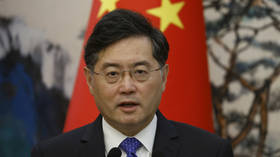China makes a move in the war for critical materials

Although the United States and China are now talking more, in practice little has actually changed in the strategic picture of relations between the two powers.
In anticipation of Treasury Secretary Janet Yellen’s visit to the country, Beijing announced a series of export controls on critical materials required for the production of semiconductors, which is interpreted as retaliation against the US’ growing export controls targeting the development of its own industry.
The materials in question, gallium and germanium, are largely exported by China, which produces the majority of their global supply. Apart from semiconductors, the two metals are also used in products like solar panels. The US has no domestic production of gallium and germanium and has to rely on imports. This means that Beijing has struck a critical strategic weakness amidst Washington’s own attempts to forcibly re-write and re-shore the global semiconductor supply chain.
The emerging Cold War between the US and China is fought over supply chains, that is control over key materials and the ability to produce public goods. Since the Donald Trump administration came into office in 2017, the US has begun to “roll back” globalization by placing preference on a foreign policy of great-power competition, believing that open markets and global supply chains have empowered states that are hostile to American interests. Therefore, supply chains should be politicized in order to justify sufficient American control over them, and therefore retain Washington’s global dominance.
To that end, US officials often talk about “resilient supply chains” in their public rhetoric, but what this actually means is an effort to push China out of those chains by diversifying, re-shoring and friend-shoring the production of critical goods to end Beijing’s manufacturing monopoly over them, while also stopping China from advancing up critical technology chains. To this end, the US has blacklisted a number of Chinese technology companies, banning them from receiving critical technologies, and has also sought to curb the export of semiconductor-making equipment to the country by co-opting allies.
While doing this, Washington has pressured global semiconductor firms to build capacity in the US under promise of subsidies, seeking to “re-write” the global technology supply chain around itself while keeping China down. For the most part, Beijing has been very cautious about responding to such hostility, if at all. However, in recent months China has slowly begun to edge up the pressure against the US in the field of semiconductors, and despite Washington’s own ambitions to dominate the industry, one obvious flaw in their strategy is that the US itself does not have direct access to all the raw materials required to make semiconductors. China has now finally exploited this Achilles’ heel and announced export controls over the sale of these critical materials, targeting the US specifically. It is unlikely, on the other hand, to be aimed at Asian countries who rely on these Chinese materials to produce for their own industries, such as South Korea.
What is the logic of this? Not only to stifle the US’ semiconductor production ambitions by making the costs more expensive and production less efficient (consider that the second-largest producer of Gallium is the Russian Federation) but also to force Asian semiconductor industries to continue to invest in Chinese production by limiting their choices. In this case, China maintains leverage to keep the supply chain concentrated around itself and prevent America from realizing its vision of a completely de-Sinicized semiconductor industry, and building a new chain “around China.” This can also be used to stop the US from attempting to build up alternative supply chains in critical goods materials in rival states such as India.
This only goes to underline the realism of how short-sighted America’s attempts to try and crush China’s semiconductor rise are. When a nation possesses critical commodities or materials, it is near impossible to isolate it from global markets when the demand for those goods is critical. This is why the West was never able to similarly cut Russia out of global energy and commodity markets. Sure, the US might be forced to get the gallium it needs from more expensive sources, or even go through third countries, but it is only going to be more expensive and counterproductive. This only further highlights the harm which US “anti-globalization” policies, in the name of opposing so called competitors, is truly doing to itself and the global economy.
The statements, views and opinions expressed in this column are solely those of the author and do not necessarily represent those of RT.













